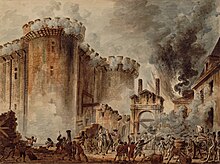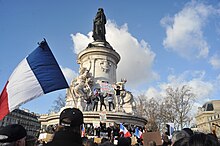Etymology
The name "France" comes from the
Latin Francia, which means "country of the
Franks". Originally it applied to the whole
Empire of the Franks. Modern France is still named today
Francia in Italian or Spanish languages and
Frankreich in German language (
Frankrijk in
Dutch), meaning "Frank
Reich", the Realm of the Franks.
There are various theories as to the origin of the name Frank. Following the precedents of
Edward Gibbon and
Jacob Grimm, the name of the Franks has been linked with the word
frank (
free) in English.It has been suggested that the meaning of "free" was adopted because, after the conquest of Gaul, only Franks were free of taxation. An other theory is that it is derived from the
Proto-Germanic word
frankon, which translates as
javelin or
lance as the throwing axe of the Franks was known as a
francisca. It seems that these weapons were named because of their use by the Franks, and not the other way around.
History
Prehistory

One of the
Lascaux paintings of which depicts a horse (
Dordogne, approximately 18,000 BC).
The oldest traces of
human life in what is now France date from approximately 1.8 million years ago.
[21] Humans were then confronted by a hard and variable climate, marked by several glacial eras, which led them to a
nomadic hunter-gathererlife. France has a large number of decorated caves from the
upper Paleolithic era, including one of the most famous and best preserved:
Lascaux(approximately 18,000 BC).
At the end of the last glacial period (10,000 BC), the climate softened and from approximately 7,000 BC, this part of Western Europe entered the Neolithic era and its inhabitants became sedentary. After strong demographic and agricultural development between the 4th and 3rd millennia, metallurgy appeared at the end of the 3rd millennium, initially working gold,copper and bronze, and later iron.France has numerous megalithic sites from the Neolithic period, including the exceptionally dense Carnac stones site (approximately 3,300 BC).
Antiquity
In 600 BC,
Ionian Greeks, originating from
Phocaea, founded the
colony of Massalia (present-day
Marseille), on the shores of the
Mediterranean Sea. This makes it France's oldest city.At the same time, some Gallic Celtic tribes penetrated parts of the current territory of France, and this occupation spread to the rest of France between the 5th and 3rd century BC.

The concept of
Gaul emerged at that time; it corresponds to the territories of Celtic settlement ranging between the
Rhine, the
Atlantic Ocean, the
Pyrenees and the Mediterranean. The borders of modern France are roughly the same as those of ancient Gaul, which was inhabited by Celtic
Gauls. Gaul was then a prosperous country, of which the southernmost part was heavily subject to Greek and Roman influences.
Around 390 BC the Gallic
chieftain Brennus and his troops made their way to Italy through the
Alps, defeated the Romans in the
Battle of the Allia, and besieged and
ransomed Rome. The Gallic invasion left Rome weakened and the Gauls continued to harass the region until 345 BC, when they entered into a formal peace treaty with Rome. But the Romans and the Gauls would maintain an adversarial relationship for the next several centuries and the Gauls would remain a threat in
Italia.
Around 125 BC, the south of Gaul was conquered by the Romans, who called this region
Provincia Nostra ("Our Province"), which over time evolved into the name
Provence in French.
Julius Caesar conquered the remainder of Gaul and overcame a revolt carried out by the Gallic chieftain
Vercingetorix in 52 BC. Gaul was divided by
Augustus into Roman provinces.Many cities were founded during the
Gallo-Roman period, including
Lugdunum (present-day
Lyon), which is considered to be the capital of the Gauls.These cities were built in traditional Roman style, with a
forum, a
theatre, a
circus, an
amphitheatre and
thermal baths. The Gauls mixed with Roman settlers and eventually adopted Roman culture and
Roman speech (
Latin, from which the French language evolved). The
Roman polytheism merged with the
Gallic paganism into the same
syncretism.
From the 250s to the 280s AD, Roman Gaul suffered a serious crisis with its
fortified borders protecting
THE EMPIRE being attacked on several occasions by
barbarians. Nevertheless, the situation improved in the first half of the 4th century, which was a period of revival and prosperity for Roman Gaul. In 312, the emperor
Constantin I converted to Christianity. Christians, persecuted until then, increased rapidly across the entire Roman Empire. But, from the beginning of the 5th century, the
Barbarian Invasions resumed, and
Germanic tribes, such as the
Vandals,
Suebi and
Alans crossed the Rhine and settled in Gaul, Spain and other parts of the
collapsing Roman Empire.
Early Middle Ages
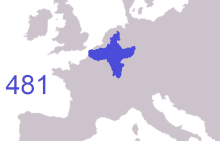
Frankish expansion from 481 to 843/870.
The pagan
Franks, from whom the ancient name of "Francie" was derived, originally settled the north part of
Gaul, but under
Clovis I conquered most of the other kingdoms in northern and central Gaul. In 498, Clovis I was the first Germanic conqueror after the fall of the Roman Empire to convert to Catholic Christianity, rather than
Arianism; thus France was given the title "Eldest daughter of the Church" (
French: La fille aînée de l’Église) by the papacy,and French kings would be called "the Most Christian Kings of France" (
Rex Christianissimus).
The Franks embraced the Christian
Gallo-Roman culture and ancient Gaul was eventually renamed
Francia ("Land of the Franks"). The Germanic Franks adopted
Romanic languages, except in northern Gaul where Roman settlements were less dense and where
Germanic languages emerged. Clovis made Paris his capital and established the
Merovingian dynasty, but his kingdom would not survive his death. The Franks treated land purely as a private possession and divided it among their heirs, so four kingdoms emerged from Clovis's: Paris,
Orléans,
Soissons, and
Rheims. The
last Merovingian kings lost power to their
mayors of the palace(head of household). One mayor of the palace,
Charles Martel, defeated an
Islamic invasion of Gaul at the
Battle of Tours (732) and earned respect and power within the Frankish kingdoms. His son,
Pepin the Short, seized the crown of Francia from the weakened Merovingians and founded the
Carolingian dynasty. Pepin's son,
Charlemagne, reunited the Frankish kingdoms and built a vast empire across
Western and Central Europe.
Proclaimed
Holy Roman Emperor by
Pope Leo III and thus establishing in earnest the French government's longtime
historical association with the
Catholic Church, Charlemagne tried to revive the
Western Roman Empire and its cultural grandeur. Charlemagne's son,
Louis I (emperor 814–840), kept
THE EMPIRE united; however, this Carolingian Empire would not survive his death. In 843, under the
Treaty of Verdun,
THE EMPIRE was divided between Louis' three sons, with
East Francia going to
Louis the German,
Middle Francia to
Lothair I, and
West Francia to
Charles the Bald. West Francia approximated the area occupied by, and was the precursor, to modern France.
During the 9th and 10th centuries, continually threatened by
Viking invasions, France became a very decentralised state: the nobility's titles and lands became hereditary, and the authority of the king became more religious than secular and thus was less effective and constantly challenged by powerful noblemen. Thus was established
feudalism in France. Over time, some of the king's vassals would grow so powerful that they often posed a threat to the king. For example, after the
Battle of Hastings in 1066,
William the Conqueror added "King of England" to his titles, becoming both the vassal to (as Duke of
Normandy) and the equal of (as king of England) the king of France, creating recurring tensions.
High Middle Ages
The Carolingian dynasty ruled France until 987, when
Hugh Capet, Duke of France and Count of Paris, was crowned
King of the Franks.
[37] His descendants – the
Capetians, the
House of Valois, and the
House of Bourbon – progressively unified the country through wars and dynastic inheritance into the Kingdom of France, which was fully declared in 1190 by
Philip II Augustus. The French kings played a prominent role in most
Crusades in order to restore Christian access to the
Holy Land. French knights made up the bulk of the steady flow of reinforcements throughout the two-hundred-year span of the Crusades. French knights also comprised the majority in both the
Hospital and the
Temple orders. The later, in particular, held numerous properties throughout France and by the 13th century was the principal bankers for the French crown, until
Philip IV annihilated the order in 1307. The
Albigensian Crusadewas launched in 1209 to eliminate the heretical
Cathars in the south-western area of modern-day France. In the end, the Cathars were exterminated and the autonomous
County of Toulouse was annexed into the kingdom of France. Later Kings expanded their
domain to cover over half of modern continental France, including most of the North, Centre and West of France. Meanwhile, the royal authority became more and more assertive, centred on a
hierarchically conceived society distinguishing
nobility, clergy, and
commoners.
Charles IV the Fair died without an heir in 1328. Under the rules of the
Salic law the crown of France could not pass to a woman nor could the line of kingship pass through the female line. Accordingly, the crown passed to Philip of Valois, a cousin of Charles, rather than through the female line to Charles' nephew, Edward, who would soon become
Edward III of England. During the reign of
Philip of Valois, the French monarchy reached the height of its medieval power. Philip's seat on the throne was contested by Edward III of England and in 1337, on the eve of the first wave of the
Black Death, England and France went to war in what would become known as the
Hundred Years' War. The exact boundaries changed greatly with time, but French landholdings of the
English Kings remained extensive for decades. With charismatic leaders, such as
Joan of Arc and
La Hire, strong French counterattacks won back English continental territories. Like the rest of Europe, France was struck by the Black Death; half of the 17 million population of France died.
Early modern period
The French Renaissance saw a spectacular cultural development and the first standardization of the French language, which would become the
official language of Franceand the language of Europe's aristocracy. It also saw a long set of wars, known as the
Italian Wars, between the Kingdom of France and the powerful
Holy Roman Empire. French explorers, such as
Jacques Cartier or
Samuel de Champlain, claimed lands in the Americas for France, paving the way for the expansion of the
First French colonial empire. The rise of Protestantism in Europe led France to a civil war known as the
French Wars of Religion, where, in the most notorious incident, thousands of
Huguenots were murdered in the
St. Bartholomew's Day massacre of 1572.The Wars of Religion were ended by
Henry IV's
Edict of Nantes, which granted some freedom of religion to the Huguenots.
The monarchy reached its peak during the 17th century and the reign of Louis XIV. By turning powerful feudal lords into
courtiers at the
Palace of Versailles, Louis XIV's personal power became unchallenged. Remembered for his numerous wars, he made France the leading European power. France became the
most populous country in Europe and had tremendous influence over European politics, economy, and culture. French became the most-used language in diplomacy, science, literature and international affairs, and remained so until the 20th century. France obtained many overseas possessions in the Americas, Africa and Asia. Louis XIV also
revoked the Edict of Nantes, forcing thousands of Huguenots into exile.
Under
Louis XV, Louis XIV's grandson, France lost
New France and most of its
Indian possessions after its defeat in the
Seven Years' War, which ended in 1763. Its
European territory kept growing, however, with notable acquisitions such as
Lorraine (1766) and
Corsica (1770). An unpopular king, Louis XV's weak rule, his ill-advised financial, political and military decisions – as well as the debauchery of his court– discredited the monarchy and arguably led to the French Revolution 15 years after his death.
Louis XVI, Louis XV's grandson, actively
supported the Americans, who were seeking their
independence from Great Britain (realized in the
Treaty of Paris (1783)). The example of the
American Revolution and the financial crisis that followed France's involvement in it were two of many contributing factors to the French Revolution. Much of the
Enlightenment occurred in French intellectual circles, and major scientific breakthroughs and inventions, such as the
discovery of oxygen (1778) and the first
hot air balloon carrying passengers (1783), were achieved by French scientists. French explorers, such as
Bougainville and
Lapérouse, took part in the
voyages of scientific exploration through maritime expeditions around the globe. The Enlightenment philosophy, in which
reason is advocated as the primary source for
legitimacy and
authority, undermined the power of and support for the monarchy and helped pave the way for the French Revolution.
Modern period
The absolute monarchy was subsequently replaced by a
constitutional monarchy. Through the
Declaration of the Rights of Man and of the Citizen, France established fundamental rights for men. The Declaration affirms "the natural and imprescriptible rights of man" to "liberty, property, security and resistance to oppression". Freedom of speech and press were declared, and arbitrary arrests outlawed. It called for the destruction of aristocratic privileges and proclaimed freedom and equal rights for all men, as well as access to public office based on talent rather than birth. While Louis XVI, as a
constitutional king, enjoyed popularity among the population, his disastrous
flight to Varennes seemed to justify rumours he had tied his hopes of political salvation to the prospects of foreign invasion. His credibility was so deeply undermined that the
abolition of the monarchy and establishment of a republic became an increasing possibility.
Louis XVI was
convicted of
treason and
guillotined in 1793. Facing increasing pressure from European monarchies, internal guerrilla wars and
counterrevolutions (such as the
War in the Vendée or the
Chouannerie), the
young Republic fell into the
Reign of Terror. Between 1793 and 1794, between 16,000 and 40,000 people were executed. In Western France, the civil war between the
Bleus ("Blues", supporters of the Revolution) and the
Blancs ("Whites", supporters of the Monarchy) lasted from 1793 to 1796 and led to the loss of between 200,000 and 450,000 lives. Both foreign armies and French counterrevolutionnaries were crushed and the French Republic survived. Furthermore, it extended greatly its boundaries and established "
Sister Republics" in the surrounding countries. As the threat of a foreign invasion receded and France became mostly pacified, the
Thermidorian Reaction put an end to
Robespierre's rule and to the Terror. The
abolition of slavery and male
universal suffrage, enacted during this radical phase of the revolution, were cancelled by subsequent governments.
After his
brief return from exile, Napoleon was finally defeated in 1815 at the
Battle of Waterloo, the monarchy was
re-established (1815–1830), with new constitutional limitations. The discredited Bourbon dynasty was overthrown by the
July Revolutionof 1830, which established the constitutional
July Monarchy, which lasted until 1848, when the
French Second Republic was proclaimed, in the wake of the European
Revolutions of 1848. The abolition of slavery and male
universal suffrage, both briefly enacted during the French Revolution were re-enacted in 1848. In 1852, the
president of the French Republic,
Louis-Napoléon Bonaparte, Napoleon I's nephew, was proclaimed emperor of the
second Empire, as Napoleon III. He multiplied French interventions abroad, especially in
Crimea, in
Mexico and
Italy. Napoleon III was unseated following defeat in the
Franco-Prussian War of 1870 and his regime was replaced by the
Third Republic. France had
colonial possessions, in various forms, since the beginning of the 17th century, but in the 19th and 20th centuries, its
global overseas colonial empire extended greatly and became the second largest in the world behind the
British Empire. Including
metropolitan France, the total area of land under French
sovereignty almost reached 13 million square kilometres in the 1920s and 1930s, 8.6% of the world's land. In 1905,
state secularism was
officially established.
Contemporary period
In 1940 France was
invaded and occupied by
Nazi Germany. Metropolitan France was divided into a
German occupation zone in the north and
Vichy France, a newly established authoritarian regime collaborating with Germany, in the south, while
Free France, the government-in-exile led by
Charles de Gaulle, was set up in London. From 1942 to 1944, about 160,000 French citizens, including around
75,000 Jews, were deported to
death camps and
concentration camps in Germany and Poland.On 6 June 1944 the
Alliesinvaded Normandy and in August they
invaded Provence. Over the following year the Allies and the
French Resistance emerged victorious over the
Axis powers and French sovereignty was restored with the establishment of the
Provisional Government of the French Republic (GPRF). This interim government, established by de Gaulle, aimed to continue to
wage war against Germany and to
purge collaborators from office. It also made several important reforms (suffrage extended to women, creation of the
Social security, founding of the
École nationale d'administration).
In 1958, the weak and unstable Fourth Republic gave way to the
Fifth Republic, which contained a strengthened Presidency.In the latter role, Charles de Gaulle managed to keep the country together while taking steps to end the war. The Algerian War was concluded with the
Évian Accords in 1962 that led to Algerian independence. France granted independence progressively to its colonies. A vestige of the colonial empire are the
French overseas departments and territories.
In the context of the
Cold War, de Gaulle pursued a policy of "national independence" towards the
Western and
Eastern blocs. To this end, he withdrew from
NATO's military integrated command, he launched a
nuclear development program and made France the
fourth nuclear power. He
restored cordial
Franco-German relationsin order to create a European counterweight between the American and Soviet spheres of influence. However, he opposed any development of a
supranational Europe, favouring a Europe of
sovereign Nations. In the wake of the series of worldwide
protests of 1968, the
revolt of May 1968 had an enormous social impact. In France, it is considered to be the watershed moment when a conservative moral ideal (religion, patriotism, respect for authority) shifted towards a more liberal moral ideal (
secularism,
individualism,
sexual revolution). Although the revolt was a political failure, as the
Gaullist party emerged even stronger than before, it announced a split between the French and de Gaulle who resigned shortly after.
In the post-Gaullist era, France remained one of the most developed
economy in the World, but faced several economic crises that resulted in high unemployment rate and increasing public debt. Lately, France has been at the forefront of the development of a supranational
European Union, notably by adopting the
Euro currency.France has also gradually but fully reintegrated NATO and has participated since then in most of NATO sponsored wars
France received many
immigrants since the 19th century to support its
economic growth, they were mostly male
foreign workers who generally returned home when not employed. During the 1970s, France simultaneously faced economic crisis and allowed immigrants (mostly from
Muslim World) to permanently
settle in France with their families and to acquire French citizenship. It resulted in hundreds of thousands of Muslims, especially to the larger cities, living in subsidized public housing and suffering from very high unemployment rates.It led to tensions and civil unrest between local population and radicalized newcomers, which eventually peaked with the
2015 Île-de-France attacks which in turn provoked the
largest public rallies in French history, gathering 4.4 millions people.
Geography

A relief map of Metropolitan France, showing cities with over 100,000 inhabitants.
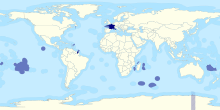
France has the World's second largest territorial waters.
From northeast to southwest, Metropolitan France shares borders with
Belgium,
Luxembourg,
Germany,
Switzerland,
Italy,
Monaco,
Spain and
Andorra. France also borders
Suriname to its west and
Brazil to its east and south, by way of the overseas region of
French Guiana, which is considered an integral part of the Republic. France also shares a border with the
Kingdom of the Netherlands, through the Caribbean island of
Saint Martin.
The territory of the French Republic consists of
The European territory of France covers 547,030 square kilometres (211,209 sq mi), the largest among
European Unionmembers. France's total land area, with its overseas departments and territories (excluding
Adélie Land), is 674,843 km
2(260,558 sq mi), 0.45% of the total land area on Earth. France possesses a wide variety of landscapes, from coastal plains in the north and west to mountain ranges of the
Alps in the south-east, the
Massif Central in the south-central and
Pyrenees in the south-west.
Due to its numerous
Overseas departments and territories scattered on all oceans of the planet, France possesses the second-largest
Exclusive economic zone(EEZ) in the world, covering 11,035,000 km
2 (4,260,000 mi
2), just behind the EEZ of the United States (11,351,000 km
2 / 4,383,000 mi
2), but ahead of the EEZ of Australia (8,148,250 km
2 / 4,111,312 mi
2). Its EEZ is covering approximately 8% of the total surface of all the EEZs of the world.
At 4,810.45 metres (15,782 ft)
[69] above sea level, the highest point in Western Europe,
Mont Blanc, is situated in the Alps on the border between France and Italy. France also has extensive river systems such as the
Seine, the
Loire, the
Garonne, and the
Rhone, which divides the Massif Central from the Alps and flows into the Mediterranean Sea at the
Camargue. Corsica lies off the Mediterranean coast.
Climate
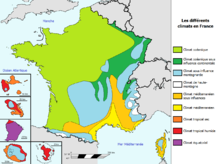
Climates of France: Oceanic (light green); semi-continental (dark green); mediterranean (yellow and light orange); mountain (blue and white); tropical (dark orange and red); and equatorial (purple).
Metropolitan France has four broad climate zones:
Except in the south which is generally dry, rain is evenly dispersed throughout the year.














